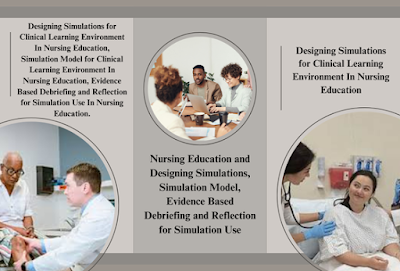The Designing Simulations Simulation Model Evidence Based Debriefing and Reflection for Simulation Use In Nursing Education. Educational simulation is a teaching method that tests participants’ knowledge and skills by placing them in scenarios where they must actively solve problems.
The Designing Simulations Simulation Model Evidence Based Debriefing and Reflection for Simulation Use In Nursing Education
Nursing simulation labs replicate a clinical environment and allow nursing students to safely practice nursing scenarios and hone their skills before applying them in clinical and practical exercises with real patients. The goal of the debriefing process is to gain knowledge, improve future performance, and promote the transfer and integration of learning into practice.
Simulation provides nursing students with a safe and controlled environment to practice procedures and interventions without endangering real patients. This allows nursing students to learn from mistakes, gain confidence, and hone their skills before entering the clinical setting. Simulations are teaching scenarios in which students are placed in a “world” defined by the instructor, which represents a reality in which the students interact. The instructor controls the parameters of this “world” and uses them to help students achieve their learning objectives. Simulation-based teaching is a pedagogical approach that provides students with the opportunity to practice learned skills in real-life situations.
Reflection for Simulation Use In Nursing Education
1. Systematic Design Approach
Simulations in nursing education should be meticulously planned. A systematic approach is essential for the successful design, implementation, and evaluation of simulations. The Jeffries Simulation Framework (2005) provides a structured method to guide these activities, ensuring that simulations support effective learning outcomes.
2. Developing Simulation Scenarios
When creating simulation scenarios, consider the following key components:
- Objectives and Learning Goals: Ensure that scenarios are designed with clear objectives and learning goals. For instance, a scenario involving an insulin-dependent patient should focus on relevant problems and problem-solving skills without introducing unnecessary complications.
- Peer Review: After developing the simulation template, have it reviewed by content experts. This helps to incorporate evidence-based practices and ensures that the content is accurate and relevant to current healthcare standards.
- Pilot Testing: Test the simulation with a sample of the target audience to confirm that it meets the appropriate skill level and includes sufficient decision-making points to engage students effectively.
3. Simulation Resources
Educators can access various resources for designing simulations, including regional and national workshops, conferences, and publications. Notable references include Campbell & Daley (2008), Guhde (2011), and Jeffries (2007).
Simulation Models for Clinical Learning Environments
1. Structured Frameworks
A national framework developed by the National League for Nursing provides a structured model for designing and implementing simulations. This model outlines the essential steps for creating effective simulations and assessing learning outcomes.
2. Design Features
Key design features for clinical simulations include:
- Problem-Solving Components: Tailor the complexity of problem-solving components to the students’ level. Novice students might work on simpler issues, while advanced students could tackle more complex scenarios that involve prioritization and critical decision-making.
Evidence-Based Debriefing and Reflection for Simulation Use
1. Importance of Debriefing
Debriefing is crucial for facilitating reflection on clinical encounters. It should ideally be twice as long as the simulation and involve active participation from all learners. The debriefing environment should be supportive and safe to encourage open discussion.
2. Reflective Observation
Debriefing incorporates reflective observation and abstract conceptualization, drawing on the experiential learning cycle proposed by Kolb (1984). This process involves:
- Concrete Experience: Engaging in the simulation.
- Reflective Observation: Reflecting on the experience.
- Abstract Conceptualization: Deriving meaning from the reflection.
- Active Experimentation: Applying the learned concepts to future scenarios.
3. Debriefing Objectives
The goals of debriefing include:
- Describing the Experience: Allowing learners to share their perceptions.
- Reviewing Objectives: Guiding a review of the patient scenario and learning goals.
- Correcting Misconceptions: Reinforcing correct practices and addressing misunderstandings.
4. Evidence-Based Strategies
The National League for Nursing advocates for using evidence-based resources to enhance debriefing skills. The Debriefing Assessment for Simulation in Healthcare (DASH) tool is a valuable resource for evaluating and improving debriefing practices. This tool helps facilitators assess their ability to conduct effective debriefings based on established behaviors and learning principles.
5. Handling Challenges
Facilitators may face challenges such as:
- Blame-Setting: Avoiding assigning blame for performance issues.
- Defensiveness: Managing learners who are defensive or self-critical.
- Facilitating Reflection: Guiding learners to reflect on their experiences without providing direct answers.
6. Structured Debriefing
Debriefings should be well-planned and structured, focusing on guiding learners through reflection rather than providing corrective instruction. Utilize open-ended questions and pauses to encourage meaningful participation and ensure that learners can transfer their insights to other situations.
Conclusion
Effective simulation design and debriefing are critical for enhancing nursing education. By following these guidelines, educators can create valuable learning experiences that bridge theoretical knowledge with practical application, fostering critical thinking and professional growth in nursing students.
Designing Simulations Simulation Model Evidence Based Debriefing and Reflection for Simulation Use In Nursing Education
Designing Simulations Simulation Model Evidence Based Debriefing and Reflection for Simulation Use In Nursing Education
Designing Simulations Simulation Model Evidence Based Debriefing and Reflection for Simulation Use In Nursing Education
Read More:
https://nurseseducator.com/didactic-and-dialectic-teaching-rationale-for-team-based-learning/
https://nurseseducator.com/high-fidelity-simulation-use-in-nursing-education/
First NCLEX Exam Center In Pakistan From Lahore (Mall of Lahore) to the Global Nursing
Categories of Journals: W, X, Y and Z Category Journal In Nursing Education
AI in Healthcare Content Creation: A Double-Edged Sword and Scary
Social Links:
https://www.facebook.com/nurseseducator/
https://www.instagram.com/nurseseducator/
https://www.pinterest.com/NursesEducator/
https://www.linkedin.com/in/nurseseducator/
https://www.researchgate.net/profile/Afza-Lal-Din
https://scholar.google.com/citations?hl=en&user=F0XY9vQAAAAJ
